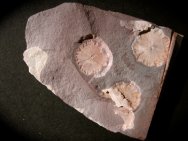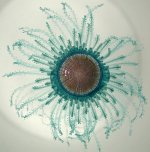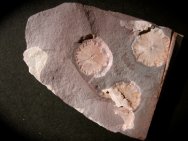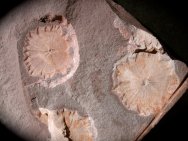Enigmatica:
resembling Porpita porpita
Phylum Incertae sedis
But, morphologically
like:
Phylum
Cnidaria, Subphylum Medusozoa, Class Hydrozoa, Order Anthomedusae,
Family Porpitidaee
Geological
Time: Ediacaran, 580 million years ago
Size: The
Porpita average 5/8” in diameter on a small plate
Fossil Site:
Ranford Formation, Kunnunarra, West Australia
Fossil Code:
PFO468
Price: Sold
 Description:
This putative Cnidarian comes from the Ranford formation of Australia.
It dates to the Ediacaran Period, nearly 40 million years before
the Cambrian Explosion. Like most Ediacaran fossils, whether
they are truly fossils or pseudofossils is debated and equivocal.
For these, some argue they are cnidarian medusaforms and some
that they are non-biogenically produced artifacts. Description:
This putative Cnidarian comes from the Ranford formation of Australia.
It dates to the Ediacaran Period, nearly 40 million years before
the Cambrian Explosion. Like most Ediacaran fossils, whether
they are truly fossils or pseudofossils is debated and equivocal.
For these, some argue they are cnidarian medusaforms and some
that they are non-biogenically produced artifacts.
They
bear a striking resemblance to the extant pelagic cnidarian
hydroid porpita porpita (or  blue
button), and I'll go with that associated taxonomy above, or
just use enigmatica. The animal fossil record
from the ediacaran is sparse, especially because animals had yet
to evolved hard shells. The blue button lives on the surface of
the sea and consists of two main parts: the float and the hydroid
colony. The hard golden-brown float is round, almost flat, and
about one inch wide. The hydroid colony, which can range from
bright blue turquoise to yellow, resembles tentacles like those
of the jellyfish. blue
button), and I'll go with that associated taxonomy above, or
just use enigmatica. The animal fossil record
from the ediacaran is sparse, especially because animals had yet
to evolved hard shells. The blue button lives on the surface of
the sea and consists of two main parts: the float and the hydroid
colony. The hard golden-brown float is round, almost flat, and
about one inch wide. The hydroid colony, which can range from
bright blue turquoise to yellow, resembles tentacles like those
of the jellyfish.
The
Ediacaran biota include the oldest definite multicellular organisms
with tissues, and the most common
types resemble segmented worms, fronds, disks, or immobile bags.
They bear little resemblance to modern lifeforms, and their relationship
even with the later life forms of the Cambrian explosion is difficult
to interpret. The evolutionary divergence of cnidarian and bilaterian
lineages from their remote metazoan ancestor occurred at an unknown
depth in time before the Cambrian, since crown group representatives
of each are found in Lower Cambrian fossil assemblages. The multicellular
cnidarians evolved early on earth and despite their primitive
nature have endured for hundreds of million of years since. It
remains
uncertain whether bilaterians evolved from early cnidarians or
from the hypothesized triploblastic ancestors of cnidarians. These fossils are very rare and have been legally collected and
exported.
- Also see:
Ellis L. Yochelson and Charles E. Mason. 1986. A Chondrophorine
Coelenterate from the Borden Formation (Lower Mississippian)
of Kentucky, Journal of Paleontology, Vol. 60, No. 5 (Sep., 1986),
pp. 1025-1028
- Chen,
J.-Y., Oliveri, P., Gao, F., Dornbos, S.Q., Li, C-W., Bottjer,
D.J. and Davidson, E.H. (August 2002). "Precambrian Animal
Life: Probable Developmental and Adult Cnidarian Forms from Southwest
China" (PDF). Developmental Biology 248 (1): 182–196.
|
|

 blue
button), and I'll go with that associated taxonomy above, or
just use enigmatica. The animal fossil record
from the ediacaran is sparse, especially because animals had yet
to evolved hard shells. The blue button lives on the surface of
the sea and consists of two main parts: the float and the hydroid
colony. The hard golden-brown float is round, almost flat, and
about one inch wide. The hydroid colony, which can range from
bright blue turquoise to yellow, resembles tentacles like those
of the jellyfish.
blue
button), and I'll go with that associated taxonomy above, or
just use enigmatica. The animal fossil record
from the ediacaran is sparse, especially because animals had yet
to evolved hard shells. The blue button lives on the surface of
the sea and consists of two main parts: the float and the hydroid
colony. The hard golden-brown float is round, almost flat, and
about one inch wide. The hydroid colony, which can range from
bright blue turquoise to yellow, resembles tentacles like those
of the jellyfish.
